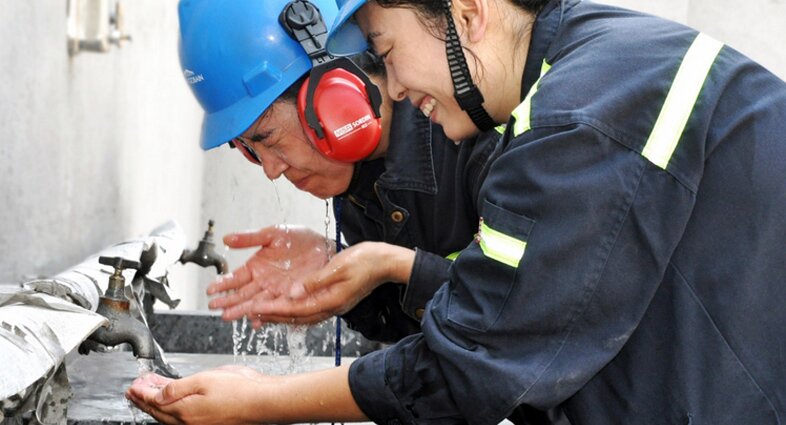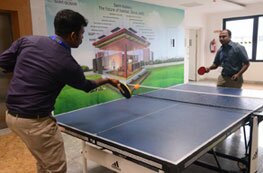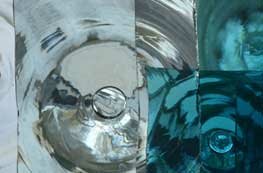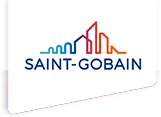Saint Gobain Research India
Limit Our Environmental Impact

ENVIRONMENT
Committed To Setting The Example
Saint-Gobain works to preserve the environment from the potential impacts of its processes and services. Four priorities have been identified to fight against climate change:- Assess and manage risks.
- Implement best existing techniques and practices.
- Innovate to invent the best future techniques and practices.
- Involve employees over the long term in protecting the environment.
Long-term objectives:
- Zero environmental accidents,
- Minimum impact from Saint-Gobain activities on the environment.
Major Environmental Challenges
Raw Materials And Waste
Reducing waste is a priority for the Group. In addition to recovering its own production waste, Saint-Gobain also uses recycled materials from outside sources, such as cullet and recovered scrap metal, to optimize its raw material consumption. The primary method for reducing resource consumption in glass furnaces is to include cullet (crushed recycled glass) among the raw materials.Objective for 2025:
- Reduce non-recovered waste by 50% (base 2010),
- Long-term objective: Zero.
Energy, Atmospheric Emissions And Climate Change
Objective: Understand and share best practices and techniques and deploy action plans to consume the least energy and produce the least atmospheric emissions possible.CO2 is the main greenhouse gas emitted by the Group's activities. A carbon assessment was conducted at 31 Saint-Gobain companies in France, representing 75% of the Group's total workforce, taking into account emissions from energy use, processes, shipping, commuting and business travel and raw material purchasing.
Saint-Gobain has participated in the Carbon Disclosure Project (CDP) since 2003.
Water
Saint-Gobain's water policy, published in 2011, applies to all Group sites worldwide. It confirms the Group's commitment to reducing the quantitative and qualitative impact of its activities on water resources as much as possible, both in terms of withdrawals and discharges.Since 2012, the Group has participated in the CDP Water Disclosure, which is designed to encourage companies to produce a detailed report of the risks and opportunities in their water management and to communicate the results in a transparent manner.
Objective for 2025:
- Reduce industrial effluent by 80% (base 2010),
- Long-term objective: Zero.
Biodiversity
Objective: Carry out local biodiversity studies for new sites and quarries and restore sites and quarries in cooperation with stakeholders, taking local biodiversity into account.The Group operates 151 underground and open-cast quarries worldwide. Of these, 79% belong to the Gypsum Activity, which has issued a biodiversity charter for its quarries. The Group's quarries are operated with the goal of preserving the environment, in compliance with local regulations
A biodiversity action program has been launched at the Group scale to improve knowledge of Saint-Gobain's natural assets. This method represents a first step in developing a cross-functional policy.
SAFETY
Committed To Setting the Example
- Assess and Control risks of both the process and equipments
- Implement best practices
- Involve employees, Contractors, Service Providers, Customers to achieve 100% safety in the work place
- Achieve High compliance in Standards: Permit to work, LOTO, Control of Contractors and Machinery safety
- Mandatory Training on Safety to all stake holders
Long-term objectives:
- Zero TF1
- Zero TF2
- 100% Compliance in all EHS standards
Major Challenges
100% Compliance in standard audits- Objective should be 80% Compliance in all the above and atleast one of the Standards should be 100% compliance
- Major Challenge is in the above is to create more safety consciousness, Involve the other stake holders in risk assessment, job safety analysis, method of statement etc., which requires more training and systems to implement
HEALTH
Committed To Setting the Example
- Implement Health policy and standardize it
- Implementing Periodical Medical check-up for all the stake holders (SG Employees, Permanent contractors, Temporary workers etc.,) and assessing it
- Identify NOS (Noise standards), TAS (Toxic Agency standard) exposures and implement the control measures
- Assess the Ergo risks and implement the solution
Long-term objectives:
- Zero ACMR chemical usage
Major Challenges
Reduction in ACMR chemicals- Major Challenge is in the above is to identify the substitution for the chemicals. As some of them are being in usage for ages, requires suitable systems for replacement. All stake holders should be taken into confident (Businesses, Customers, SG Research Peers etc.,) to achieve this.

Beach Walk
Beach walks every weekend over a month to promote an active lifestyle, de-stress and connect with natureMore

Stretching Classes
Weekly stretching sessions with a specialist to promote a more healthy and positive environmentMore

A short hike to Saint Thomas Mount
A short hike to Saint Thomas Mount after which participants were met byMore

Table Tennis
Table tennis tournaments to inculcate a spirit of friendly competitionMore

Impact of Engineering Education on Industrial Innovation
Poster 1More

For Teacher's Day
We would like to share with you about the current openings at SGRI and would br happy if you could refer us your best.More

Independence Day Quiz and Drawing Competition
SGRI celebrated the 68th Independence Day with lots of fun,fervor and activities for our team.
More

Careers An opportunity to conceptualize & demonstrate ideas in large scale and eventually scale up in manufacturing set up.
Click the Current Opening
Click the Current Opening
Focus Area
Abrasives, Ceramics, Plastics and Reinforcements Glass for Architecture & Automotive Gypsum Habitat Solutions for Hot-Humid Climates Competencies
© Saint Gobain Research India

